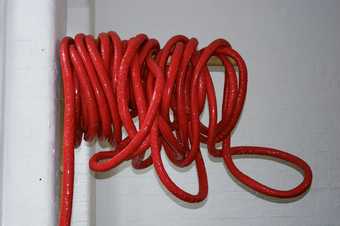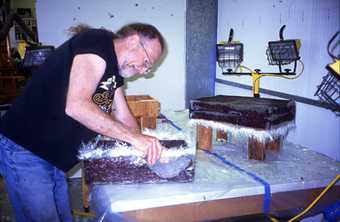Rising up or collapsing? Folding or unfolding? Exhaling or inhaling? Crouching or cringing? It seems larger and more voluminous than before. Is this because of its different location? Previously it was in Tate Britain. Then, I could walk around it and view it from the back, as well as from the sides and front. I’m now confused. I’m seeing it at Tate Modern. Is it the same Chillida? Yes, the iron bars forged into contorted loops are there as before – but the size and volume seem to have doubled.
Twisted shapes and structures have a capricious history within sculpture. The invented forms that emerge from materials being pulled, pushed, stretched, poured, piled, compressed and coiled have been frequently usurped by a preference for the appropriated and readymade. Chillida’s Modulation of Space I 1963 is a hybrid fusing both the readymade and invented form. The solid iron bars from which it is forged are themselves readymades. It is a heavy, recalcitrant, unyielding material which requires great heat to make it malleable, and great strength and skill to twist and turn it into something other than its original prepared lengths.
The transformation of the dead weight of the bars into the interlocking series of raised loops, angular sections trapped beneath and awkward protuberances which constitute Modulation of Space I has to be achieved so quickly in the forging that a moment in time is forever captured within the folds and coils of the sculpture. Similarly, the heat is somehow retained. It is as if it is still darkly smouldering, emanating an inherent sense of danger.
Modulation of Space I is delicately balanced on three points at the edges of its structure. Air circulates through its loops, counteracting its heaviness and making it seem both light in weight and absorbent to the light within the space in which it is located. The pressure of the forging process has caused raised creases to expand on the tight curves. Splits have been cut into the metal when hot to assist its moulding and modelling. The contrast between the bold structure, the thickness and darkness of the materials and the ease of the flow of the iron can also displace its sculptural qualities: it becomes a drawing seemingly scrawled into space at speed with gestural confidence.
Gravity, as well as time, heat and forged iron, are its materials. The effortless loops, arching upwards as well as folding on top of each other, defy their own weight. The visceral piling up of these apparently weightless curves begins to beg questions. How did Chillida know when to stop wrestling with the hot iron, to not add another curve or angle? When was enough enough?
The immediacy of action retained within the coiling metal is alive in its now static form. But it is anything but still. As I walk around it, I provide the movement which reveals the restlessness of this work. It is different from every point of view. It is impossible to hold it as a single image. No wonder I could not fully remember it.
Now, I begin to think of another work whose use of gravity is physical, material and anarchic. How would Chillida’s Modulation of Space I respond to sharing a space with Eva Hesse’s Contingent 1969? Her eight suspended sheets of resin and latex-soaked muslin are about as opposite as is possible to the predatory forged iron object. Suspended from fixtures overhead, the fragile sheets are openly vulnerable. Their armatureless bodies refute sculptural language, instead behaving more as painterly surfaces. But they are as sculptural as Modulation of Space I. And both pieces represent the physical and material manipulation of space, time and gravity which sculpture can exert. They are not concerned with pictorial images in three-dimensional form, but with sculpture which is rooted in actions applied to materials and processes to evidence – what? Perhaps these actions transform themselves into emotions, and that is what we are left to fathom.

Installation view of Phyllida Barlow's Scape at Spacex, Exeter (2005)
Courtesy Hauser & Wirth and New Art Centre, Roche Court © Phyllida Barlow
For me, Chillida’s contorted forms wrestled from white hot metal end up evoking power and fear – they are coiled ready to pounce. But when I walk around to the back of the sculpture, the perilously leaning forged metal bars seem both defensive and threatening in their awkwardly balanced stance. I turn to have a final look at Chillida’s piece. Its dramatic hold on me retreats. It is in its place, cordoned off and plinthed close to the gallery wall. I retain the sense of its coiled tension, its captured movement and its dangerous balance. Now, as I write this, what I am remembering isn’t visual. It is the actions of heat on iron and their enduring effects of fear, stealth and defiance. I want danger, awkwardness, a sense of perilous balance and the evidence of time through the materials and their processes to be evident in my work. I am continuously taunted by guessing when enough is enough. Modulation of Space I is inspirational as it keeps me guessing: I cannot work it out. I cannot resolve it. It is always different.
Back in my studio, paper rope coils are being bound in glossy tapes. The paper rope is rigid and recalcitrant. It is difficult to manipulate and the added tape is making it even more unyielding. These coils will be slung over a wall fitting. I want them to be a loose, unformed and unravelling kind of object. But embedded within their process of making is a deep envy for forged, white-hot metal.

